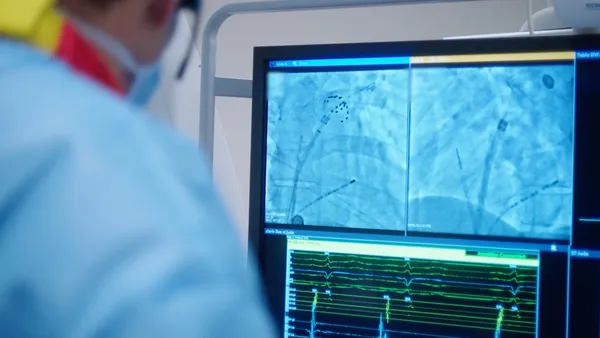Around March 2020, sponsors were in a pinch: They had to quickly embrace electronic patient reported outcomes (ePRO), electronic informed consent (eConsent) and other decentralized technologies as medical device trials — and the world, really — went virtual.
By now, that well-intentioned sprint has created a hodgepodge of disparate solutions. This new problem compounds with the fact that many eClinical solutions are built for more robust pharma trials and include unneeded features that add complexity and confusion for sites engaging in medical device protocols.
Altogether, these trends are forcing many short-staffed and burned-out sites to go back to what they know: paper logs, which ultimately can drive up costs through duplicated workflows and missing data. The problem’s not so much the tech as it is the tech’s imbalance. Most clinical trial solutions aren’t right-sized for medical device trials.
“Many sites express frustration about how hard it is to deal with the different sources of data that come with the non-integration of technology, and we’ve certainly seen a lot more of that fragmentation in the movement toward decentralized trials,” said Tina Caruana, Subject Matter Expert of eClinical Solutions at Medrio. “What happens is that this keeps sites from doing what they need to do, like caring for their patients, recruiting subjects into trials and retaining them — which are the things technology is meant to assist with in the first place.”
Disparate solutions create extra validation and login steps, which complicates workflows and creates unnecessary data. But when sponsors don’t optimize the right platforms, it can also hold data collection back. Both can delay trials in a time when competition has never been more cutthroat and the need for speed in medical device trials has never been more important.
As they address these challenges, sponsors will need to rethink their tech landscape and adopt more right-sized solutions that will actually get used and preferred, over paper. We asked Caruana for her insights on what to do.
1. Assess
Audit your tech landscape to identify what’s necessary and what’s not, Caruana suggested. Such an audit can help sponsors determine which mix of solutions, such as eConsent, ePRO and randomization and trial supply management, would be right for their trial. After all, when you use only the features that are necessary, it can support data integrity and accelerate trials for a faster market entry.
“You don’t want to throw everything at the wall all at once,” Caruana said. “The best partners are deliberate and conscientious of what is required for the study.”
Strike a right-sized balance of solutions with a trial-specific approach, she added. Depending on many factors, every protocol’s digital ecosystem can vary from one to another.
“It comes down to the protocol,” Caruana noted. “How many subjects? Who are the subjects? What are their ages? What’s the therapeutic area? All of that has bearing on the solutions you do and don’t use.”
2. Integrate
Once a sponsor understands its tech landscape, the next aim is integration — in other words, applying compatible technologies that talk with one another through more meaningful tech partnerships.
Over the past several years, vendors have used APIs as an inroad into integration, particularly as tech company mergers and acquisitions have driven the need to stitch together a mishmash of solutions. But Caruana cautioned against the overreliance on APIs, citing them as costly and a potential driver for performance issues.
“You want to look for a system that is fully and natively integrated from the same vendor,” Caruana said. “Prioritize vendors that operate from a single code base for all the tools — whether that’s eConsent, ePRO, electronic data capture or other solutions.”
By consolidating vendor contracts, you, in turn, consolidate technologies for a complementary, aligned experience. Sites need to learn only one system and it lowers complexity in trial management for all protocols, but especially decentralized ones that connect sites to their dispersed patients and CROs.
Other benefits of this model include the freedom to toggle different solutions for different trials and that it aggregates all data into one safe spot to streamline workflows, reduce inconsistencies, mitigate frustrations and minimize manual lift for sites.
3. Simplify
Integration makes things easier for users, but there are other opportunities to simplify, too.
Consider the interface. Solutions with pre-built but flexible dashboards — enabled by drag-and-drop tools with no need for coding — help sponsors start more quickly to go live faster, without relying on an outside company or specialized staff to build their unique study workflows.
Other features, like single sign-on, are just as critical to streamline experiences for sites and subjects. Ultimately, reach for solutions designed to let users do what they need to do, whether that’s enter diary information, complete a licensed form or other tasks.
“You want something intuitive and consistent in navigation and access from tool to tool,” Caruana said. “Nobody wants to relearn software every time you add a new solution to your technology ecosystem.”
4. Learn
Vendors should absolutely have the expertise to “do it all” for you, if that’s what you want. But there’s also merit in autonomy. Establish relationships with partners that can help you learn to operate independently through a blend of guided autonomy.
This means looking for those who offer training, professional services, pre-built workflows and other help tools. Continuity in support provides continuity in partnership from initial build-out to study close as your needs and capabilities change.
“I like to think of it as a crawl-walk-run metaphor,” Caruana said. “Your first study, you might need a little more assistance in terms of these training resources — just to learn the ropes. As you gain more experience, you’re better able to walk and build a lot of the infrastructure internally. Ultimately, you can build on that foundation and start to run autonomously, if that’s what you want to do.”
Right-size, but don’t revolutionize
The growing gestalt of eClinical technologies has complicated workflows and frustrated sites. Now’s the time to reassess that mix for smarter platforms that work harder for every protocol. But remember — the best technology mimics and improves upon paper.
Take the good but not the bad of traditional workflows, leaning on technology to right-size, but not revolutionize, your data-collection engine. When you do so, you might be surprised how easy things can be.
Explore more of Caruana’s insights for medical device sponsors in Medrio’s white paper, “Bring Your Medical Device Trials to Market Faster.”










